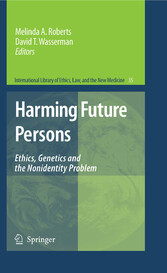Suchen und Finden
Acknowledgements
6
Contents
7
Contributors
10
Harming Future Persons: Introduction
12
1 Purpose of this Collection
12
2 The Person-Affecting Intuition and the Nonidentity Problem
13
3 The Nonidentity Cases
14
4 Three Strategies for Addressing the Nonidentity Problem
19
5 Contributions to this Collection
22
6 Conclusion
34
Notes
34
References
36
Part I
38
The Intractability of the Nonidentity Problem
39
1.1 The Logical and Metaphysical Dimensions of the Problem
39
1.2 Four Strategies for Responding to the Nonidentity Problem
41
1.3 Numerical, Biographical and Autobiographical Identity
53
1.4 Conclusion
57
Notes
57
References
60
Part II
62
Rights and the Asymmetry Between Creating Good and Bad Lives
63
2.1 The Asymmetry, Common Sense Morality and Rights
63
2.2 How the Doctrine of Negative Rights Explains the Asymmetry
64
2.3 The Grounds and Groundlessness of Rights
67
2.4 The Symmetry of Reasons of Beneficence
71
Notes
79
References
81
Asymmetries in the Morality of Causing People to Exist
82
3.1 Introduction
82
3.2 Definitions and Distinctions
83
3.3 Reasons and Values Presupposed by the Asymmetry
85
3.4 The Distinction Between Harming and Benefiting
87
3.5 The Individual-Affecting Symmetry View
91
3.6 The Antinatalist Symmetry View
94
3.7 The Impersonal Symmetry View
97
3.8 Conclusion
99
Notes
100
References
101
Part III
102
Who Cares About Identity?
103
4.1 Introduction
103
4.2 The Moral Insignificance of Transworld Identity
106
4.3 The Prudential Insignificance of Transworld Identity
112
4.4 Genes and Identity
116
Notes
120
References
122
Do Future Persons Presently Have Alternate Possible Identities?
125
5.1 The Erewhon Hypothesis
125
5.2 Variations on a Theme by Parfit
126
5.3 The No-Difference Thesis
130
5.4 Identity-Determining Choices and Identity-Determining Characteristics
131
5.5 Ambiguous “Identities”
133
5.6 Vague “Identities”
134
5.7 Alternative Conceptions of “Identity”
136
5.8 Future Persons as Vague but Identifiable Objects of Present Obligations
137
5.9 Parfit and “The Descriptive View”
142
5.10 Return to Erewhon
144
Notes
145
References
146
Rule Consequentialism and Non-identity
147
6.1 Introduction
147
6.2 Two Decisive Intuitions
148
6.3 How Simple Consequentialism Fails
151
6.4 Why Simple Consequentialism Fails
154
6.5 Rule Consequentialism
155
6.6 A Contingent Morality
159
6.7 Rule Consequentialism and Moral Philosophy
162
Notes
164
References
165
Part IV
167
Harming as Causing Harm
168
7.1 Introduction
168
7.2 Harming as Causing Harm
170
7.3 Solving the Non-identity Problem
171
7.4 Harming and Benefiting Those Who Independently Exist
176
7.5 Is Causing Harm Sufficient for Harming?
179
7.6 Conclusion
181
Notes
182
References
185
Wrongful Life and Procreative Decisions
186
8.1 Introduction
186
8.2 How Bad Is It?
188
8.3 The Philosophical Problem
188
8.4 Preventing Births to Protect Children
189
8.5 The Nonexistence Condition
192
8.6 The Human Rights Approach
197
8.7 The Non-Identity Problem
198
8.8 Conclusion
205
Notes
205
References
208
Other References
209
Harming and Procreating
210
9.1
210
9.2
212
9.3
213
9.4
215
9.5
217
9.6
221
9.7
223
9.8
225
9.9
225
9.10
226
Notes
227
References
230
The Nonidentity Problem and the Two Envelope Problem: When is One Act Better for a Person than Another?
231
10.1 Parallel Problems
231
10.2 A Person-Based Approach to Procreative Choice
235
10.3 The Nonidentity Problem
239
10.4 The Two-Envelope Problem
247
10.5 Conclusion
252
Notes
253
References
257
Part V
259
Reproduction, Partiality, and the Non-identity Problem
260
11.1 The Liberal View of Reproduction
260
11.2 Reproduction and Non-identity
261
11.3 Reproduction and Partiality
263
11.4 The Case Against Impartiality
266
11.5 The Case Against Partiality
269
11.6 A Pessimistic Conclusion?
274
Notes
276
References
276
Two Varieties of “Better-For” Judgements
278
12.1 The Principle of Procreative Beneficence
278
12.2 PPB and the Non-Identity Problem
281
12.3 Internal and External Perspective “Better-For” Judgements
282
12.4 Prospective Parenthood and the Internal Perspective
285
12.5 Principled Procreation
287
12.6 Summary
291
Notes
291
References
291
Harms to Future People and Procreative Intentions
293
13.1 Introduction
293
13.2 Must We Create the Best? Partiality Toward Future Imperfect People
294
13.3 Justifying Harm in Different-Number Cases: The Generation-Adding Policy
297
13.4 Justifying Harm in Same-Number Cases: The Chauvinist Policy
298
13.5 An Impersonal Explanation of the Chauvinist Policy
299
13.6 Limits on the Role of Procreative Intentions in Justifying Harm
301
13.7 An Alterative? Asymmetrical Responsibility for Harms and Benefits
303
13.8 The Limitations of Asymmetrical Responsibility
306
13.9 Selectivity, Partiality, and Procreative Intentions
307
13.10 Conclusion
308
Notes
309
References
312
Part VI
314
Can the Person Affecting Restriction Solve the Problems in Population Ethics?
315
14.1 Introduction
315
14.2 Comparativism
316
14.3 The Person Affecting Restriction
317
14.4 Strict Comparativism
319
14.5 Asymmetrical Comparativism
320
14.6 Inconsistency
321
14.7 Personal Good Restriction Regained
323
14.8 A Normative Version of the Restriction
324
14.9 Soft Comparativism
327
14.10 Dominated Outcomes
329
14.11 Future Populations and Trade Offs
332
14.11 Summary
334
Notes
335
References
339
Part VII
341
Implications of the Nonidentity Problem for State Regulation of Reproductive Liberty
342
15.1 Fundamental Liberties
343
15.2 Types of Harm to Future Children
344
15.3 Compelling State Interests
345
15.4 Two Different Distinctions
347
15.5 Future Children, Whoever They May Be
348
15.6 Will the Courts Agree?
352
Notes
354
References
355
Reparations for U.S. Slavery and Justice Over Time
357
Notes
363
References
363
Name Index
364
Subject Index
368
Alle Preise verstehen sich inklusive der gesetzlichen MwSt.









